Advanced Financial Accounting: Depreciation Methods Project Report
VerifiedAdded on 2023/06/11
|7
|1036
|286
Report
AI Summary
This report provides a detailed overview of depreciation in advanced financial accounting, focusing on the essential information required to calculate depreciation for a new company. It defines depreciation as the apportionment of the cost of a fixed asset over its useful life and highlights key elements such as the date placed in service, acquisition value, salvage value, estimated useful life, and the chosen depreciation method. Various depreciation methods, including the straight-line method, are discussed. The report includes a practical example demonstrating the calculation of depreciation using the straight-line method for a new company, emphasizing the importance of accurate depreciation calculations for assessing a company's financial performance. The document is available on Desklib, a platform offering study tools for students.
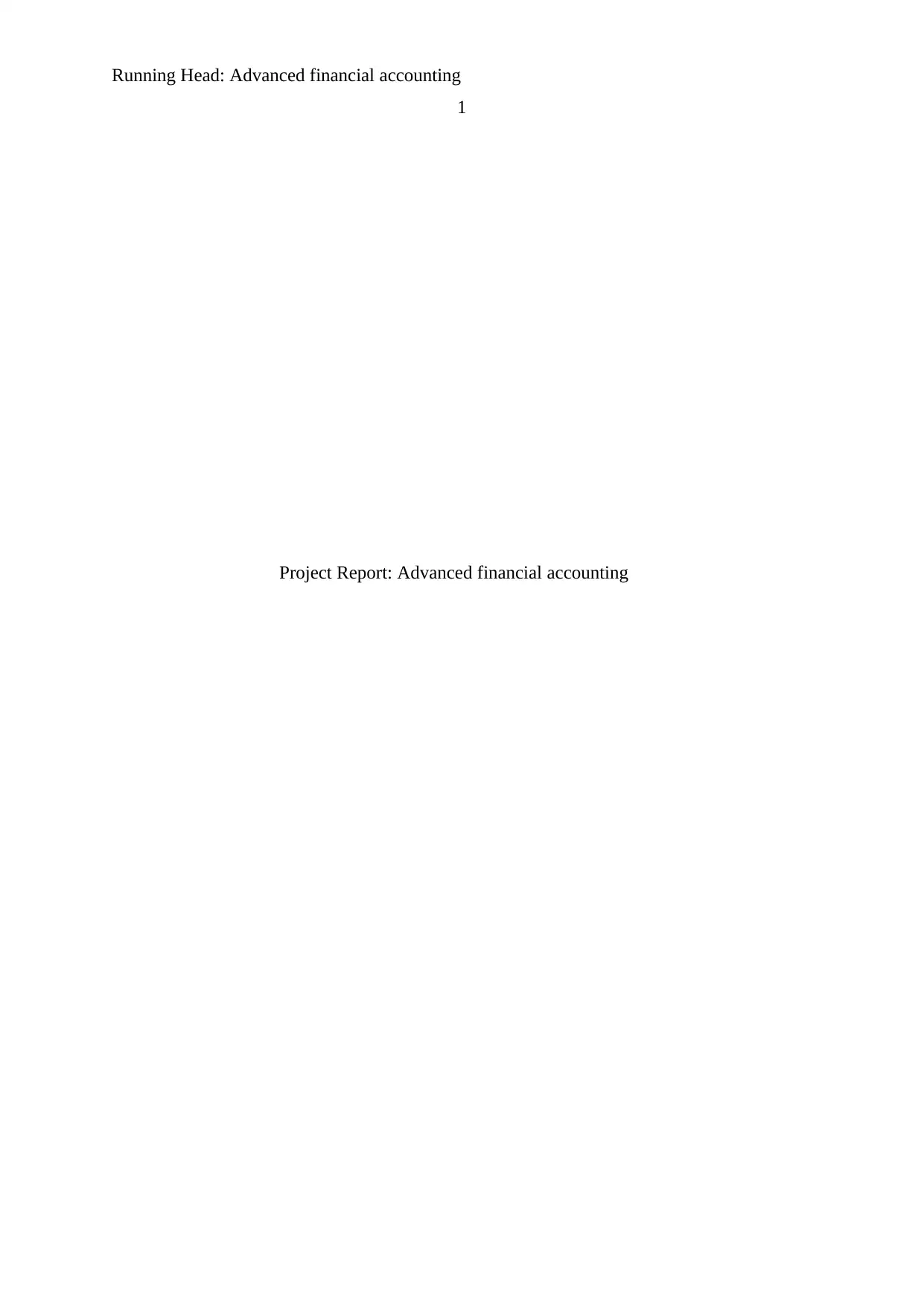
Running Head: Advanced financial accounting
1
Project Report: Advanced financial accounting
1
Project Report: Advanced financial accounting
Paraphrase This Document
Need a fresh take? Get an instant paraphrase of this document with our AI Paraphraser
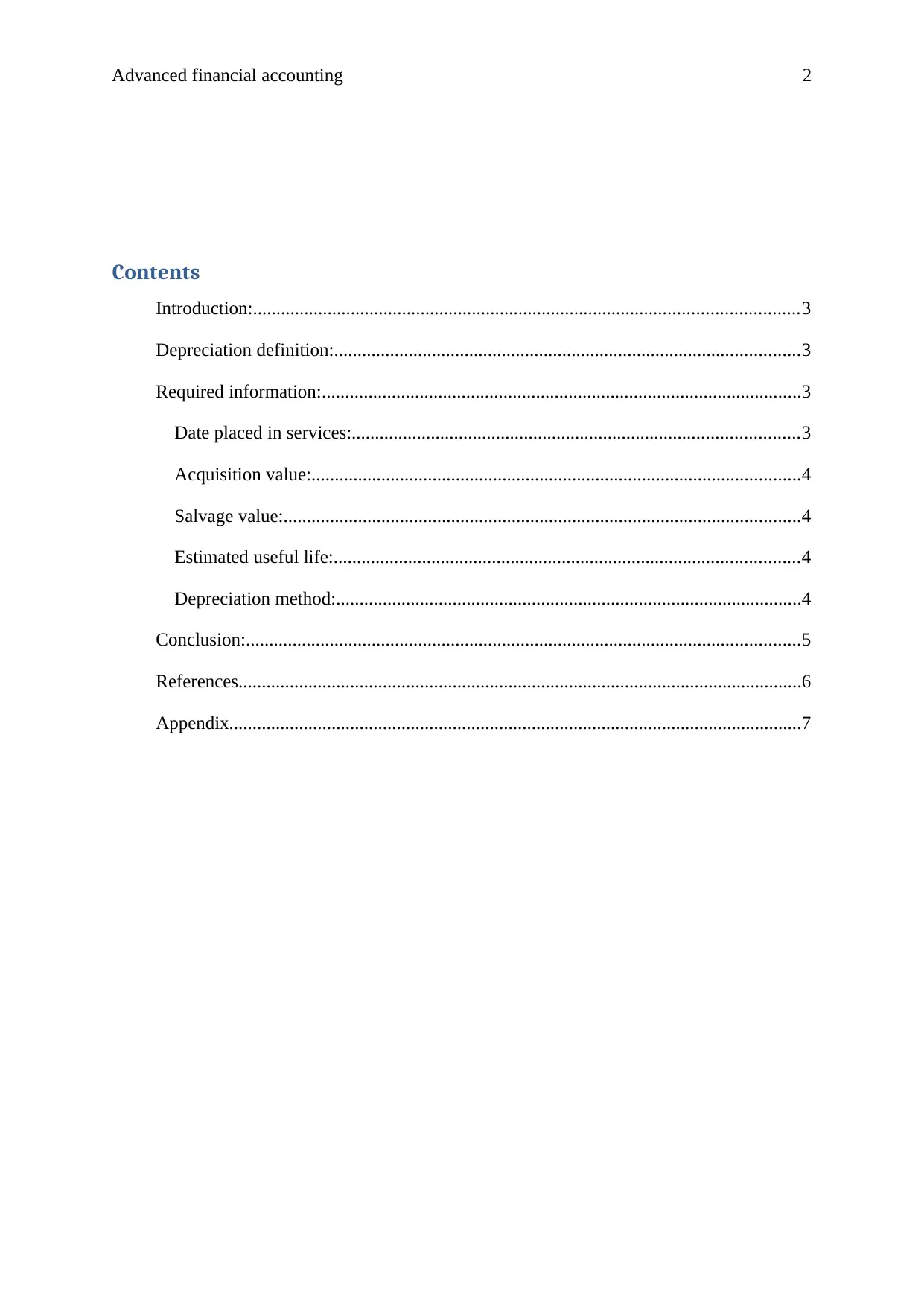
Advanced financial accounting 2
Contents
Introduction:.....................................................................................................................3
Depreciation definition:....................................................................................................3
Required information:.......................................................................................................3
Date placed in services:................................................................................................3
Acquisition value:.........................................................................................................4
Salvage value:...............................................................................................................4
Estimated useful life:....................................................................................................4
Depreciation method:....................................................................................................4
Conclusion:.......................................................................................................................5
References.........................................................................................................................6
Appendix...........................................................................................................................7
Contents
Introduction:.....................................................................................................................3
Depreciation definition:....................................................................................................3
Required information:.......................................................................................................3
Date placed in services:................................................................................................3
Acquisition value:.........................................................................................................4
Salvage value:...............................................................................................................4
Estimated useful life:....................................................................................................4
Depreciation method:....................................................................................................4
Conclusion:.......................................................................................................................5
References.........................................................................................................................6
Appendix...........................................................................................................................7
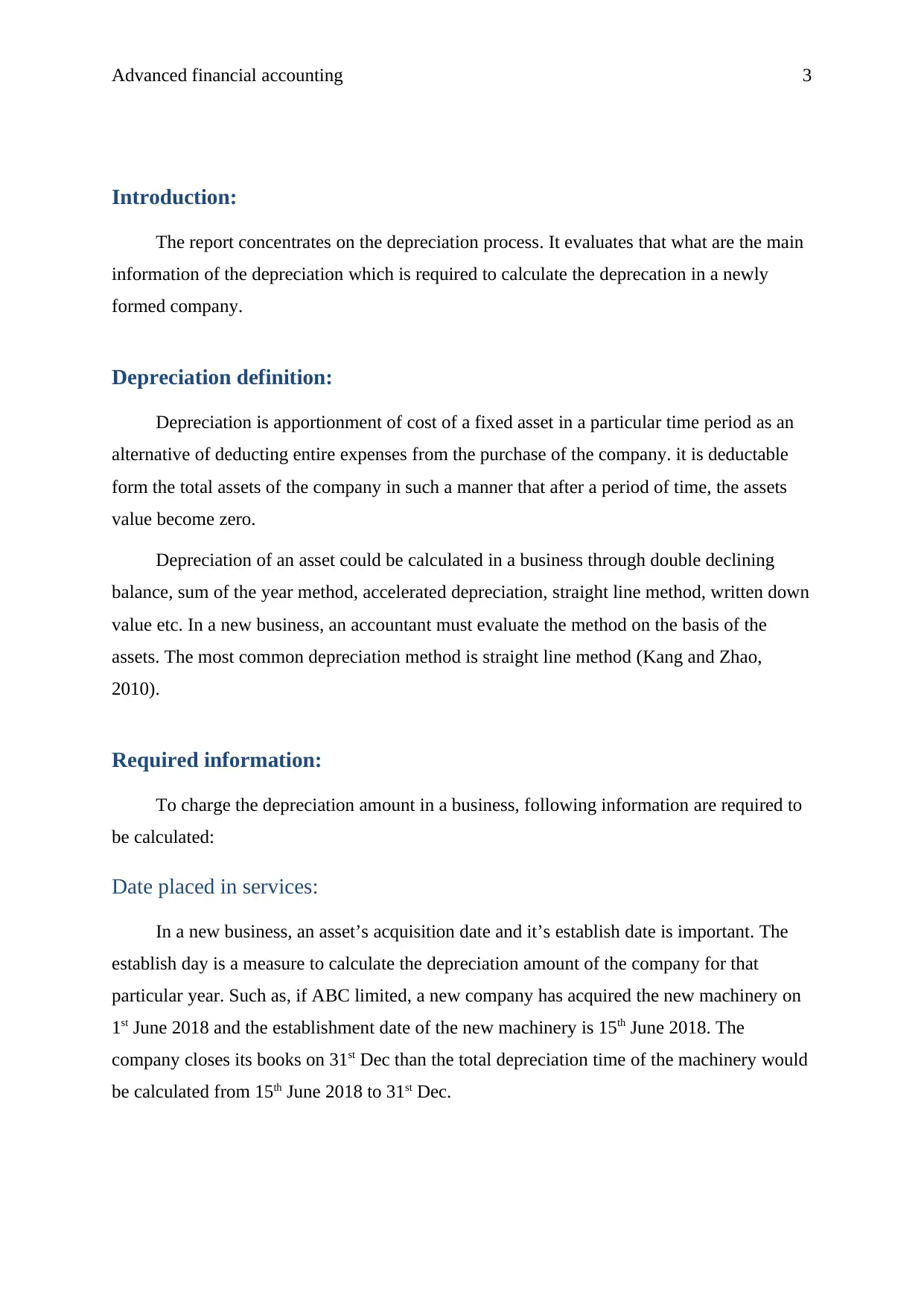
Advanced financial accounting 3
Introduction:
The report concentrates on the depreciation process. It evaluates that what are the main
information of the depreciation which is required to calculate the deprecation in a newly
formed company.
Depreciation definition:
Depreciation is apportionment of cost of a fixed asset in a particular time period as an
alternative of deducting entire expenses from the purchase of the company. it is deductable
form the total assets of the company in such a manner that after a period of time, the assets
value become zero.
Depreciation of an asset could be calculated in a business through double declining
balance, sum of the year method, accelerated depreciation, straight line method, written down
value etc. In a new business, an accountant must evaluate the method on the basis of the
assets. The most common depreciation method is straight line method (Kang and Zhao,
2010).
Required information:
To charge the depreciation amount in a business, following information are required to
be calculated:
Date placed in services:
In a new business, an asset’s acquisition date and it’s establish date is important. The
establish day is a measure to calculate the depreciation amount of the company for that
particular year. Such as, if ABC limited, a new company has acquired the new machinery on
1st June 2018 and the establishment date of the new machinery is 15th June 2018. The
company closes its books on 31st Dec than the total depreciation time of the machinery would
be calculated from 15th June 2018 to 31st Dec.
Introduction:
The report concentrates on the depreciation process. It evaluates that what are the main
information of the depreciation which is required to calculate the deprecation in a newly
formed company.
Depreciation definition:
Depreciation is apportionment of cost of a fixed asset in a particular time period as an
alternative of deducting entire expenses from the purchase of the company. it is deductable
form the total assets of the company in such a manner that after a period of time, the assets
value become zero.
Depreciation of an asset could be calculated in a business through double declining
balance, sum of the year method, accelerated depreciation, straight line method, written down
value etc. In a new business, an accountant must evaluate the method on the basis of the
assets. The most common depreciation method is straight line method (Kang and Zhao,
2010).
Required information:
To charge the depreciation amount in a business, following information are required to
be calculated:
Date placed in services:
In a new business, an asset’s acquisition date and it’s establish date is important. The
establish day is a measure to calculate the depreciation amount of the company for that
particular year. Such as, if ABC limited, a new company has acquired the new machinery on
1st June 2018 and the establishment date of the new machinery is 15th June 2018. The
company closes its books on 31st Dec than the total depreciation time of the machinery would
be calculated from 15th June 2018 to 31st Dec.
⊘ This is a preview!⊘
Do you want full access?
Subscribe today to unlock all pages.

Trusted by 1+ million students worldwide
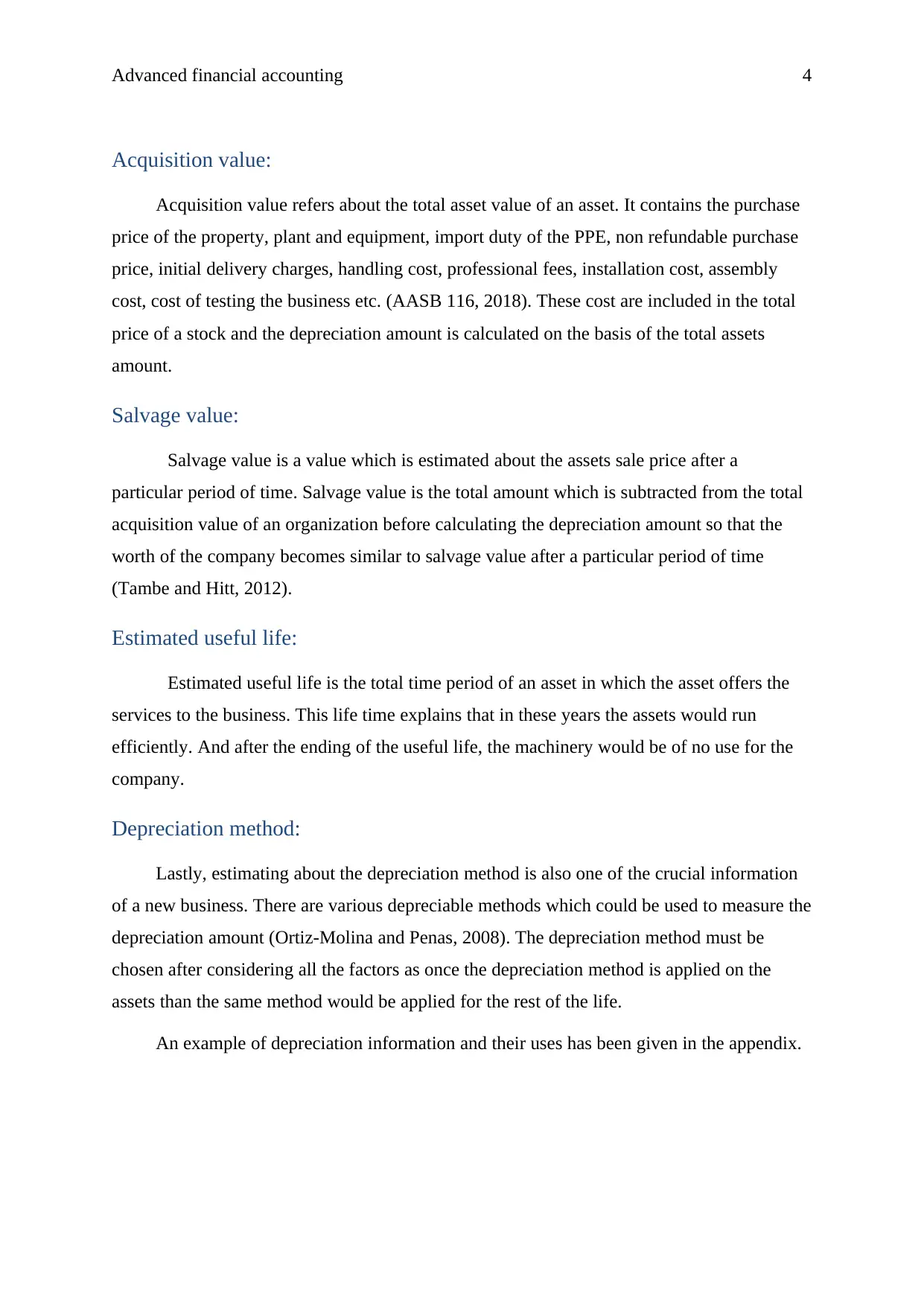
Advanced financial accounting 4
Acquisition value:
Acquisition value refers about the total asset value of an asset. It contains the purchase
price of the property, plant and equipment, import duty of the PPE, non refundable purchase
price, initial delivery charges, handling cost, professional fees, installation cost, assembly
cost, cost of testing the business etc. (AASB 116, 2018). These cost are included in the total
price of a stock and the depreciation amount is calculated on the basis of the total assets
amount.
Salvage value:
Salvage value is a value which is estimated about the assets sale price after a
particular period of time. Salvage value is the total amount which is subtracted from the total
acquisition value of an organization before calculating the depreciation amount so that the
worth of the company becomes similar to salvage value after a particular period of time
(Tambe and Hitt, 2012).
Estimated useful life:
Estimated useful life is the total time period of an asset in which the asset offers the
services to the business. This life time explains that in these years the assets would run
efficiently. And after the ending of the useful life, the machinery would be of no use for the
company.
Depreciation method:
Lastly, estimating about the depreciation method is also one of the crucial information
of a new business. There are various depreciable methods which could be used to measure the
depreciation amount (Ortiz-Molina and Penas, 2008). The depreciation method must be
chosen after considering all the factors as once the depreciation method is applied on the
assets than the same method would be applied for the rest of the life.
An example of depreciation information and their uses has been given in the appendix.
Acquisition value:
Acquisition value refers about the total asset value of an asset. It contains the purchase
price of the property, plant and equipment, import duty of the PPE, non refundable purchase
price, initial delivery charges, handling cost, professional fees, installation cost, assembly
cost, cost of testing the business etc. (AASB 116, 2018). These cost are included in the total
price of a stock and the depreciation amount is calculated on the basis of the total assets
amount.
Salvage value:
Salvage value is a value which is estimated about the assets sale price after a
particular period of time. Salvage value is the total amount which is subtracted from the total
acquisition value of an organization before calculating the depreciation amount so that the
worth of the company becomes similar to salvage value after a particular period of time
(Tambe and Hitt, 2012).
Estimated useful life:
Estimated useful life is the total time period of an asset in which the asset offers the
services to the business. This life time explains that in these years the assets would run
efficiently. And after the ending of the useful life, the machinery would be of no use for the
company.
Depreciation method:
Lastly, estimating about the depreciation method is also one of the crucial information
of a new business. There are various depreciable methods which could be used to measure the
depreciation amount (Ortiz-Molina and Penas, 2008). The depreciation method must be
chosen after considering all the factors as once the depreciation method is applied on the
assets than the same method would be applied for the rest of the life.
An example of depreciation information and their uses has been given in the appendix.
Paraphrase This Document
Need a fresh take? Get an instant paraphrase of this document with our AI Paraphraser
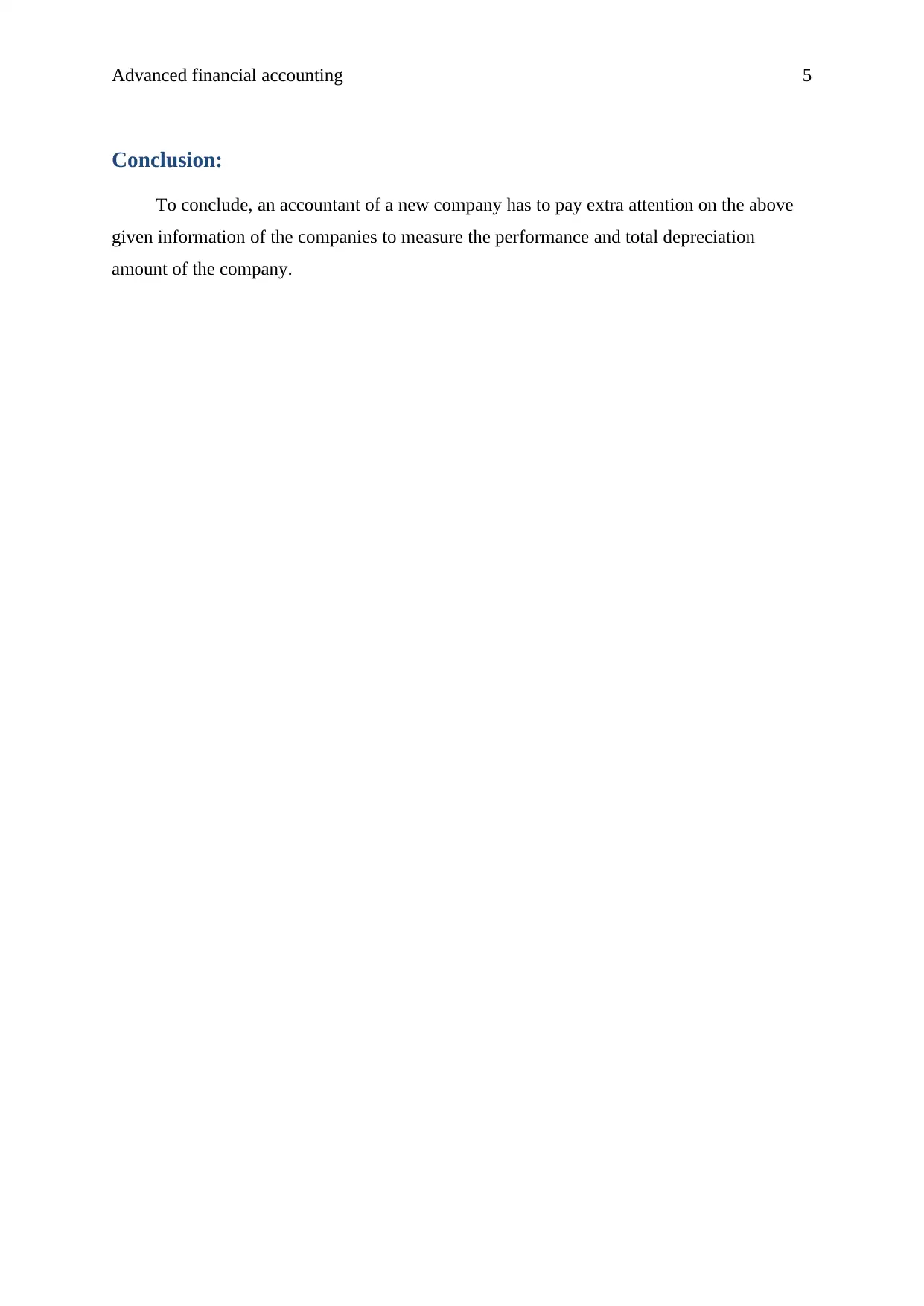
Advanced financial accounting 5
Conclusion:
To conclude, an accountant of a new company has to pay extra attention on the above
given information of the companies to measure the performance and total depreciation
amount of the company.
Conclusion:
To conclude, an accountant of a new company has to pay extra attention on the above
given information of the companies to measure the performance and total depreciation
amount of the company.
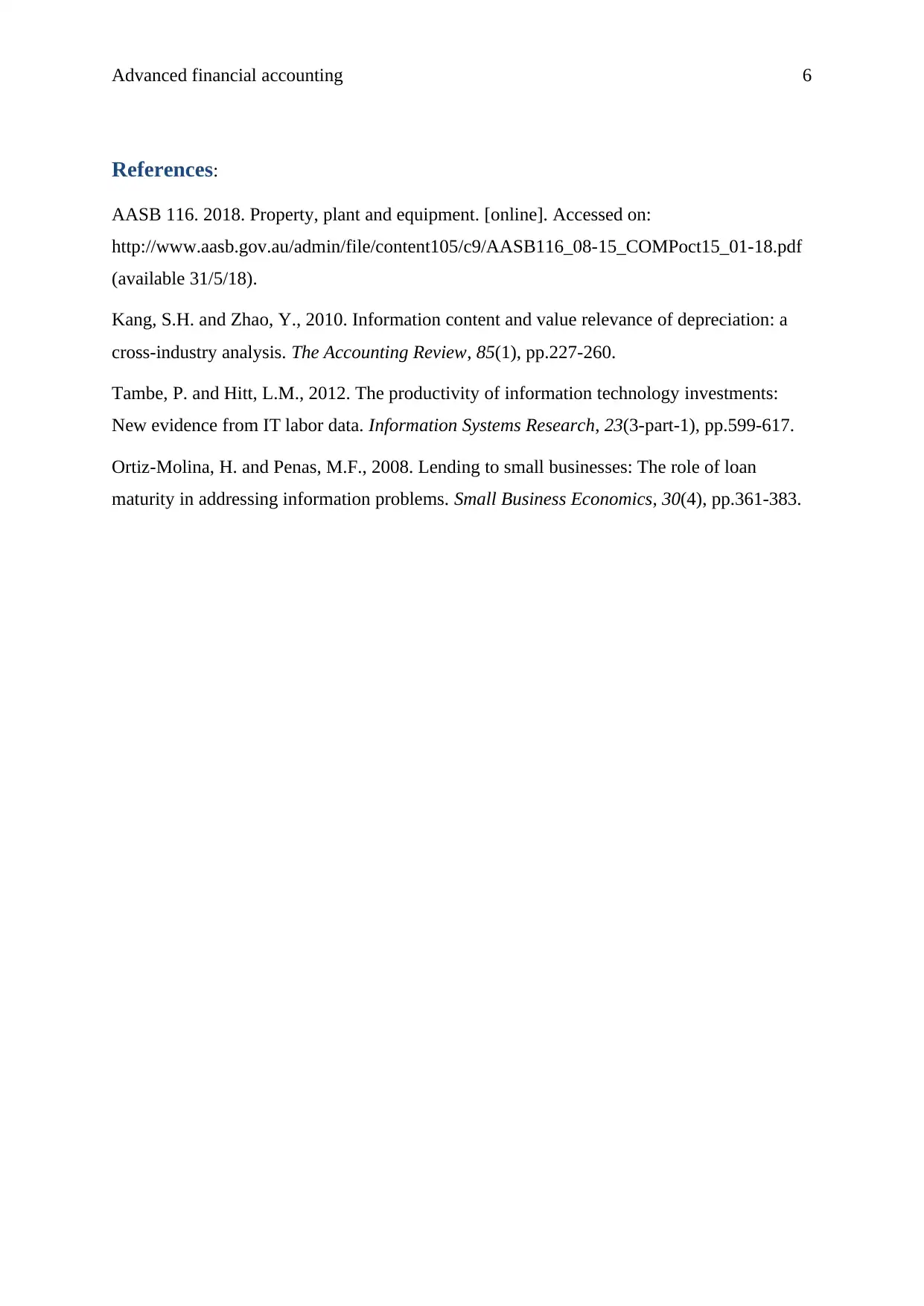
Advanced financial accounting 6
References:
AASB 116. 2018. Property, plant and equipment. [online]. Accessed on:
http://www.aasb.gov.au/admin/file/content105/c9/AASB116_08-15_COMPoct15_01-18.pdf
(available 31/5/18).
Kang, S.H. and Zhao, Y., 2010. Information content and value relevance of depreciation: a
cross-industry analysis. The Accounting Review, 85(1), pp.227-260.
Tambe, P. and Hitt, L.M., 2012. The productivity of information technology investments:
New evidence from IT labor data. Information Systems Research, 23(3-part-1), pp.599-617.
Ortiz-Molina, H. and Penas, M.F., 2008. Lending to small businesses: The role of loan
maturity in addressing information problems. Small Business Economics, 30(4), pp.361-383.
References:
AASB 116. 2018. Property, plant and equipment. [online]. Accessed on:
http://www.aasb.gov.au/admin/file/content105/c9/AASB116_08-15_COMPoct15_01-18.pdf
(available 31/5/18).
Kang, S.H. and Zhao, Y., 2010. Information content and value relevance of depreciation: a
cross-industry analysis. The Accounting Review, 85(1), pp.227-260.
Tambe, P. and Hitt, L.M., 2012. The productivity of information technology investments:
New evidence from IT labor data. Information Systems Research, 23(3-part-1), pp.599-617.
Ortiz-Molina, H. and Penas, M.F., 2008. Lending to small businesses: The role of loan
maturity in addressing information problems. Small Business Economics, 30(4), pp.361-383.
⊘ This is a preview!⊘
Do you want full access?
Subscribe today to unlock all pages.

Trusted by 1+ million students worldwide
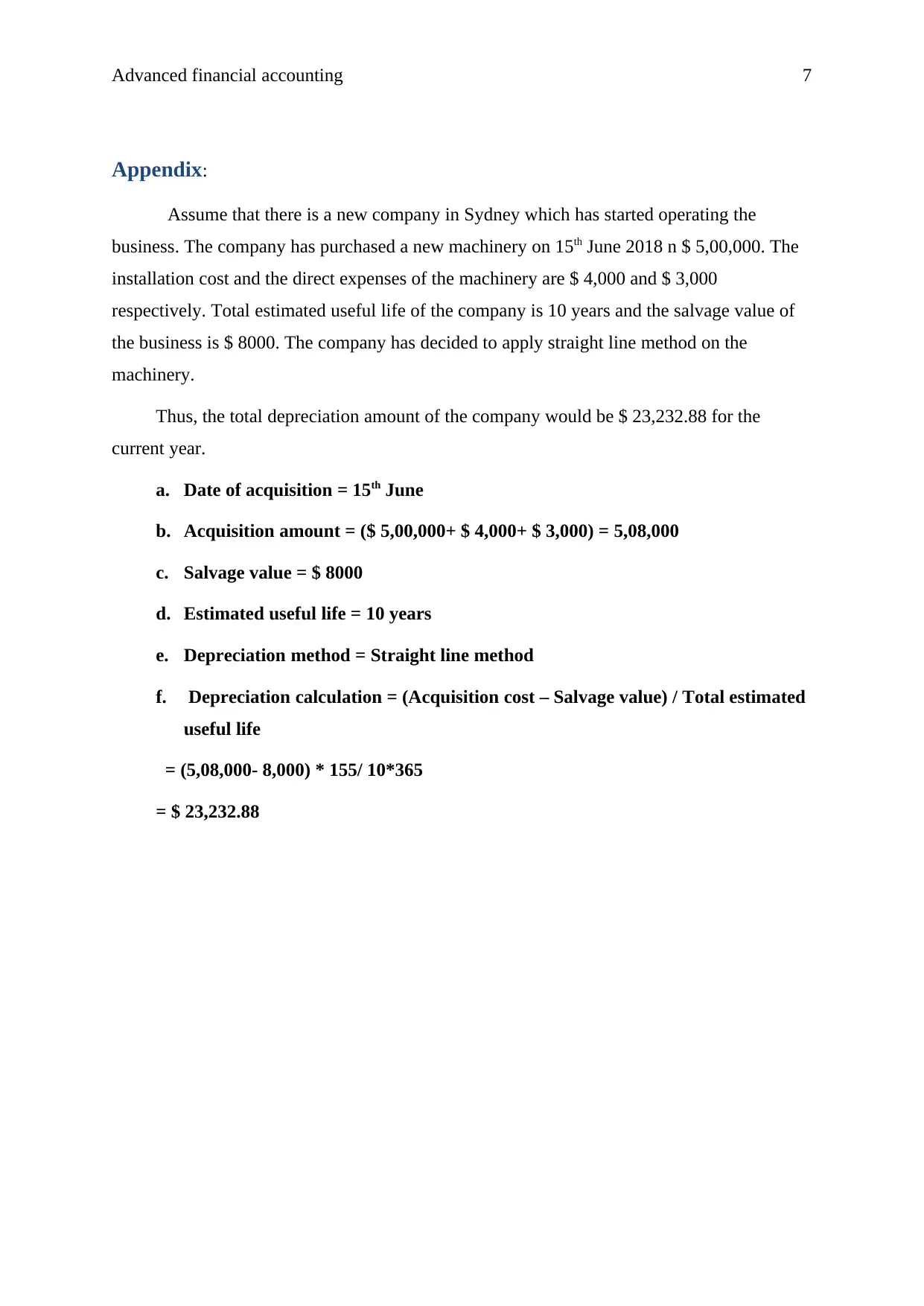
Advanced financial accounting 7
Appendix:
Assume that there is a new company in Sydney which has started operating the
business. The company has purchased a new machinery on 15th June 2018 n $ 5,00,000. The
installation cost and the direct expenses of the machinery are $ 4,000 and $ 3,000
respectively. Total estimated useful life of the company is 10 years and the salvage value of
the business is $ 8000. The company has decided to apply straight line method on the
machinery.
Thus, the total depreciation amount of the company would be $ 23,232.88 for the
current year.
a. Date of acquisition = 15th June
b. Acquisition amount = ($ 5,00,000+ $ 4,000+ $ 3,000) = 5,08,000
c. Salvage value = $ 8000
d. Estimated useful life = 10 years
e. Depreciation method = Straight line method
f. Depreciation calculation = (Acquisition cost – Salvage value) / Total estimated
useful life
= (5,08,000- 8,000) * 155/ 10*365
= $ 23,232.88
Appendix:
Assume that there is a new company in Sydney which has started operating the
business. The company has purchased a new machinery on 15th June 2018 n $ 5,00,000. The
installation cost and the direct expenses of the machinery are $ 4,000 and $ 3,000
respectively. Total estimated useful life of the company is 10 years and the salvage value of
the business is $ 8000. The company has decided to apply straight line method on the
machinery.
Thus, the total depreciation amount of the company would be $ 23,232.88 for the
current year.
a. Date of acquisition = 15th June
b. Acquisition amount = ($ 5,00,000+ $ 4,000+ $ 3,000) = 5,08,000
c. Salvage value = $ 8000
d. Estimated useful life = 10 years
e. Depreciation method = Straight line method
f. Depreciation calculation = (Acquisition cost – Salvage value) / Total estimated
useful life
= (5,08,000- 8,000) * 155/ 10*365
= $ 23,232.88
1 out of 7
Related Documents
Your All-in-One AI-Powered Toolkit for Academic Success.
+13062052269
info@desklib.com
Available 24*7 on WhatsApp / Email
![[object Object]](/_next/static/media/star-bottom.7253800d.svg)
Unlock your academic potential
Copyright © 2020–2025 A2Z Services. All Rights Reserved. Developed and managed by ZUCOL.





